Found across the world, birds with yellow heads are colorful and stand out in any environment.
Their coloring may be the result of an evolutionary trait where plumage colors change in the breeding season.
Some of the following birds with yellow heads are even yellow throughout the year.
Here are some of the species found in The United States and around the world.
Table of Contents
1. Yellow-headed Blackbird
A species characterized by the yellow appearance of its males, Yellow-headed Blackbirds (Xanthocephalus xanthocephalus) are mostly black and yellow in the case of males.
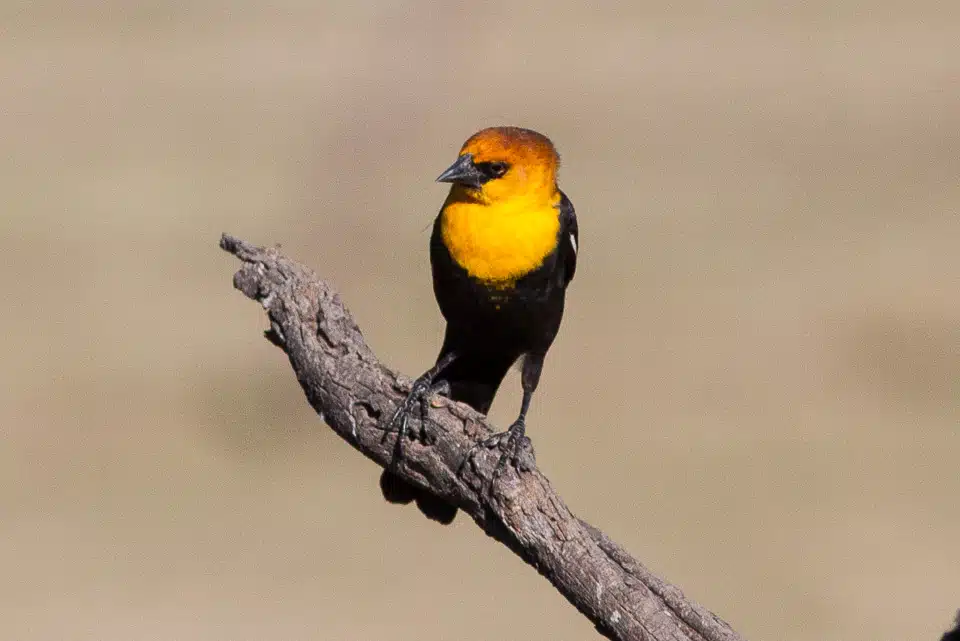
The female of the species has a brown-dominated appearance while males are black, with a yellow head and throat.
Yellow nuances on their heads vary from pale yellow to yellow-orange.
Juvenile Yellow-headed Blackbirds are brighter but may also have a yellow head.
Birds of this species are known migrators, moving South outside of their breeding range to overwinter.
These birds migrate and live in large flocks with brief pauses when they live in pairs as they breed.
Distribution – Western United States, Mexico
2. Yellow-headed Parrot
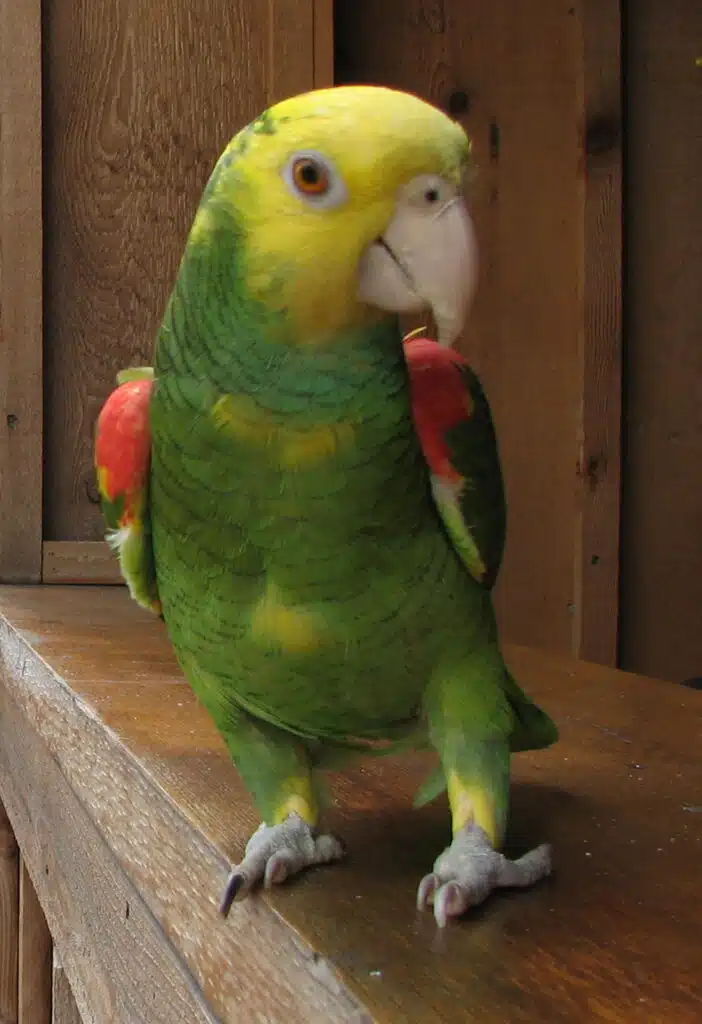
From a young age, a yellow head is seen on The Yellow-headed Parrot (Amazona oratrix).
This is a species that shows bright yellow nuances with a green body and yellow-red sections on the base of its wings.
A species of talking parrot, The Yellow-headed Parrot is frequently seen in captivity.
Also known as a large species, the parrot may even reach a size of up to 17 inches.
Outside captivity, the parrot lives in Central and South America. It favors moist forests in the areas next to rivers.
A diminishing habitat is among the main reasons for concern with the species.
Distribution – Central America, South America
3. American Goldfinch
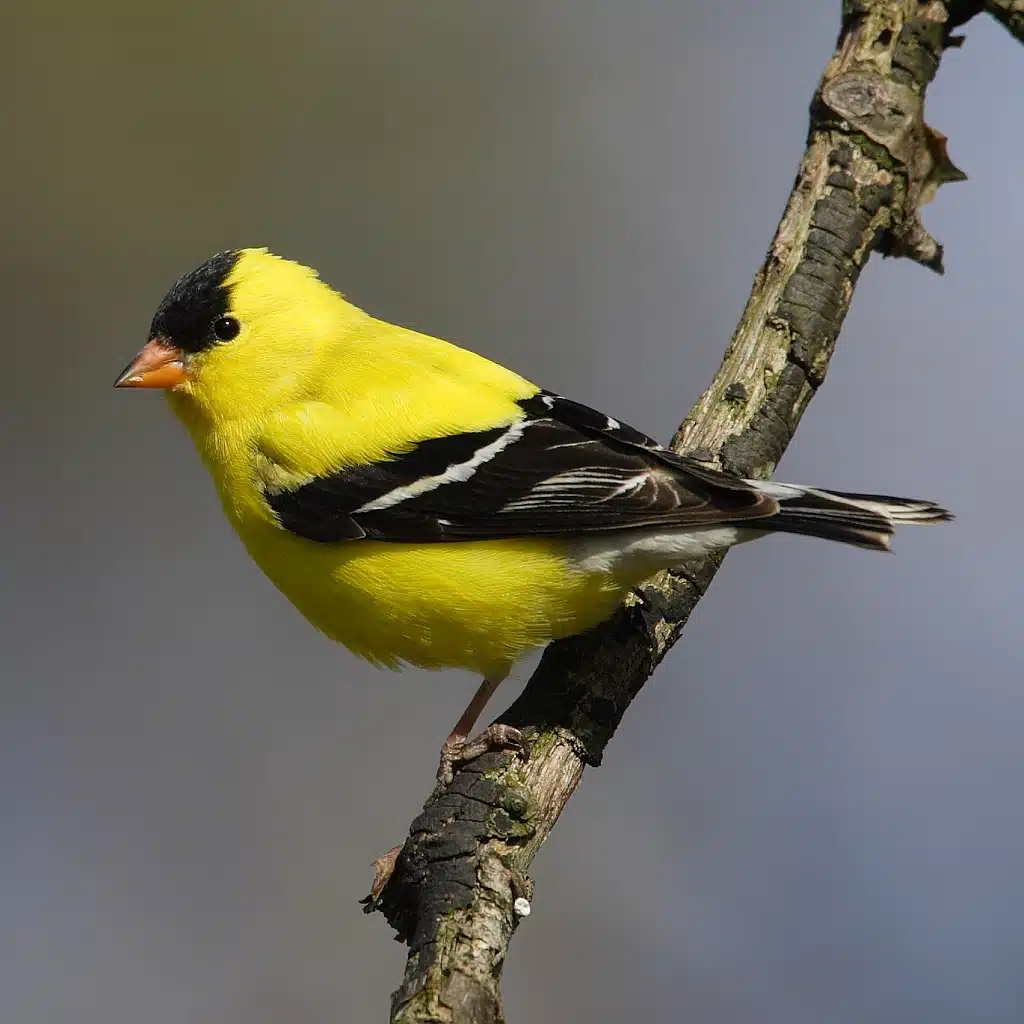
A species native to The United States, American Goldfinches (Spinus tristis) show bright yellow heads. This species is even dominated by yellow plumage.
Apart from the head, the chest and underbelly of males are also yellow while their wings are black.
Females share much of their appearance with males but are generally darker. Yellow colors may be seen on the head but they are only bright on the underbelly of females.
A common species in North America in the breeding season, this bird is known for its breeding rituals. Males chase females in flight to mark the beginning of the breeding ritual.
Distribution – Southern Canada, The United States, East Mexico
4. Yellow Warbler
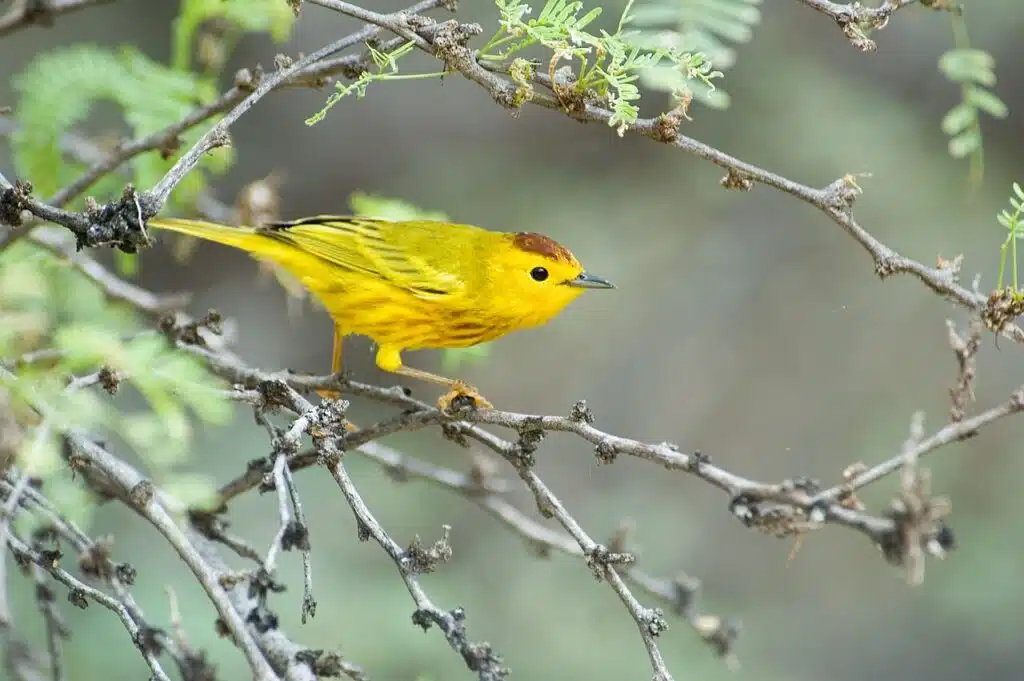
Various yellow shades are specific to the head of male and female Yellow Warblers (Setophaga petechia).
These birds may or may not change their plumage, depending on their region. Males are most likely to change their head color to a yellow head.
This yellow nuance resembles the yellow nuance of the rest of its body.
Females may also show at least partly yellow head coloring. They are mostly green-yellow and closer to green compared to males which are bright yellow.
The head and face of the male may vary between brown-red and yellow as the birds go into and out of the breeding season.
Distribution – Alaska, Canada, United States, Central America, Northern South America
5. Western Tanager
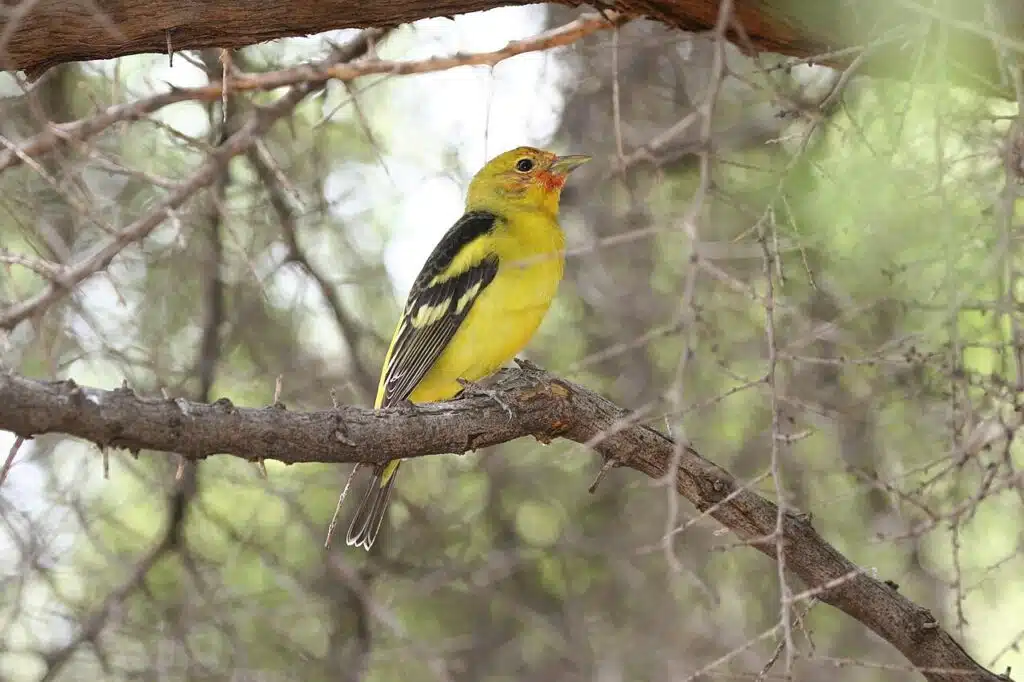
A yellow head is specific to male and female Western Tanagers (Piranga ludoviciana), under different nuances.
Males have yellow head with a red face going into the breeding season while also showing yellow and black plumage.
Females also have yellow head with a green cap, wings, and underbellies.
Growing up to a minimum size of at least 6.5 inches, male and female Western Tanagers also show the common trait of having darker wings.
Males have black wings with yellow spots while females have darker green wings with white-cream spots.
Distribution – Western North America, Mexico
6. Pine Warbler
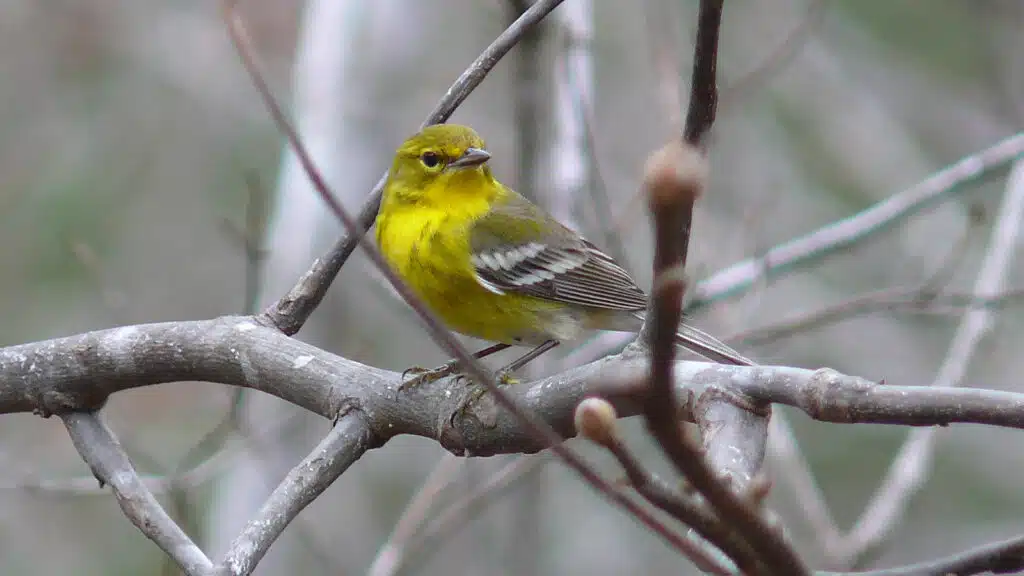
A common species in North America, Pine Warblers (Setophaga pinus) are named after their favorite food, pine cones.
These birds are often seen moving pines and poking them with their bills for seeds.
Males and females have different appearances which are mainly down to color differences as they can both reach a size of up to 7 inches (Pine Warblers have a wingspan of almost 9 inches).
A yellow head is specific to males of the species. They also show vivid yellow breasts and underbelly.
Females, on the other hand, are dominated by gray nuances and also have gray head.
Distribution – Maine to Florida and East to Texas
7. Prairie Warbler
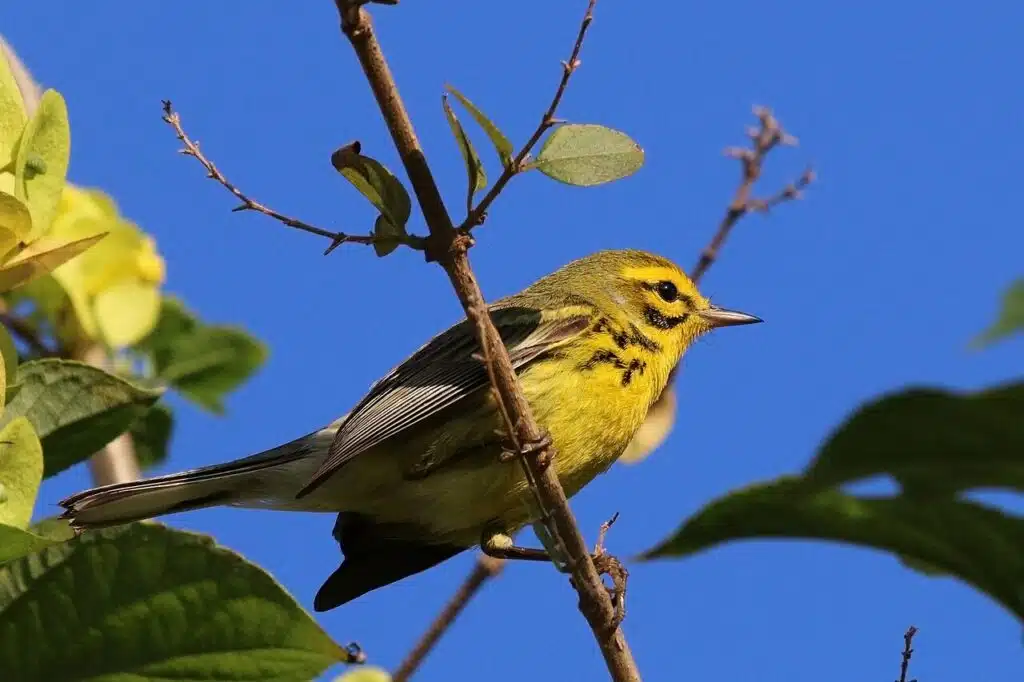
Yellow and yellow-green nuances are specific to the head of Prairie Warblers (Setophaga discolor). These are the types of birds with olive-green nuances matching their yellow plumage.
The ventral side of Prairie Warblers is also yellow while the wings can be green or olive-green.
Black streaks are also seen on the face and wings of the warbler.
With a considerable presence in Southeastern US states, Prairie Warblers move South when they migrate to overwinter.
These birds communicate by singing and they also show aggression by tuning in their singing.
Distribution – Eastern and Southeastern United States (breeding), Florida, and The Caribbean (overwintering)
8. Hermit Warbler
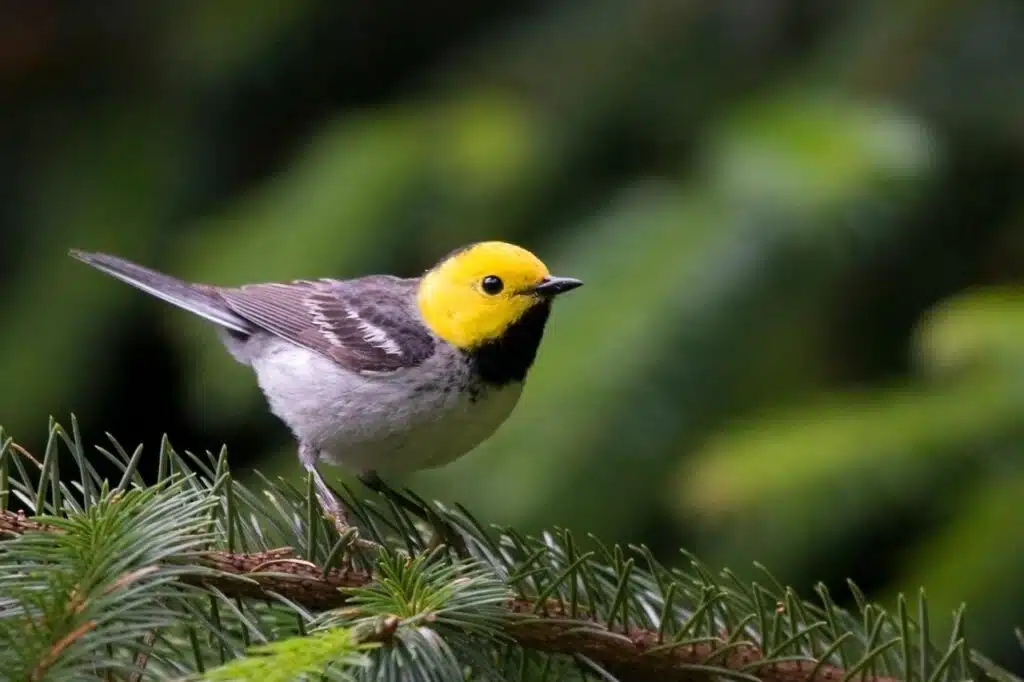
A species found in coniferous forests, Hermit Warblers (Setophaga occidentalis) are among the multiple warblers with yellow heads.
Male and female Hermit Warblers have a yellow heat, with slightly different nuances.
A bright yellow head is seen on males while females have a yellow and olive-green head.
Slightly duller in coloring, females only show a yellow head with bright gray underbellies.
These birds are found spotted on tree branches, looking for bugs and insects to feed on. Hermit Warblers can use their strong legs to hang upside down.
Distribution – Western United States, Mexico
9. Golden-cheeked Warbler
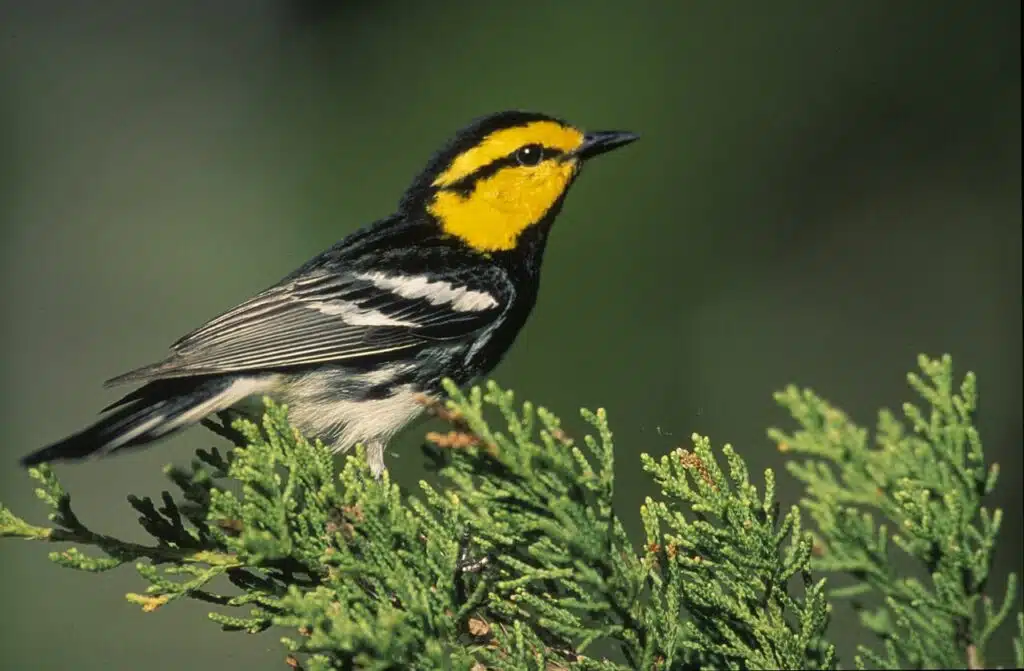
The Golden-cheeked Warbler (Setophaga chrysoparia) is named after its golden-yellow face.
Yellow cheeks contrast the black and white plumage of this warbler which shows a highly limited range in North and Central America.
Endemic to Southern Texas, Golden-cheeked Warblers around found in other US states. These birds eventually migrate South to overwinter.
Spring migration is one of the periods when the birds can be seen moving back into Texas to breed.
Both their Texas range and their overwintering locations are centered around oak or juniper trees.
Distribution – Southern Texas (breeding), Mexico, Guatemala, Honduras, Nicaragua (overwintering)
10. Swinhoe’s White Eye
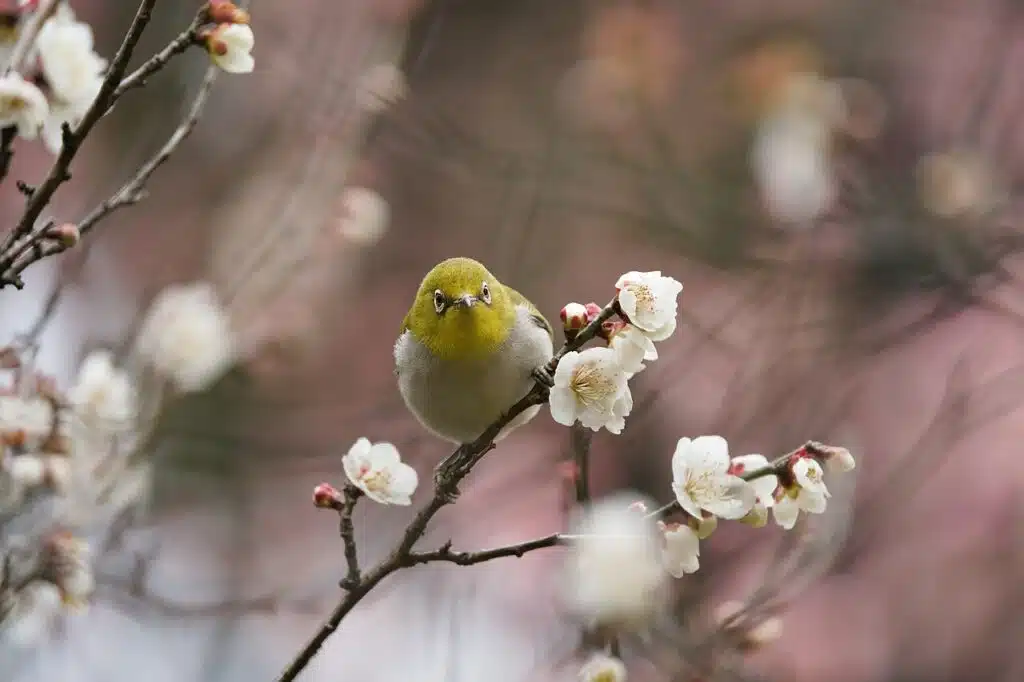
A native Taiwanese, Swinhoe’s White-Eye (Zosterops simplex) is a species named after the atypical white-eye appearance.
This species has white skin sections around the eyes but its head has a yellow-green tint.
Females of the species are dull-colored. They show a combination of dark gray and bright gray plumage.
Birds of the species have almost white underbellies and contrasting black stripes along the margins of their wings.
While the bird is native to Asia, it has been introduced around the world with varying degrees of success.
In The United States, Swinhoe’s White Eyes have adapted the best in California. However, they are still limited to a few thousand individuals.
In total, there are 5 Swinhoe’s White-Eye subspecies, most of them found in Southeast Asia. Considerable populations outside Southeast Asia and California include those in China.
Distribution – Thailand, China, California
11. Prothonotary Warbler
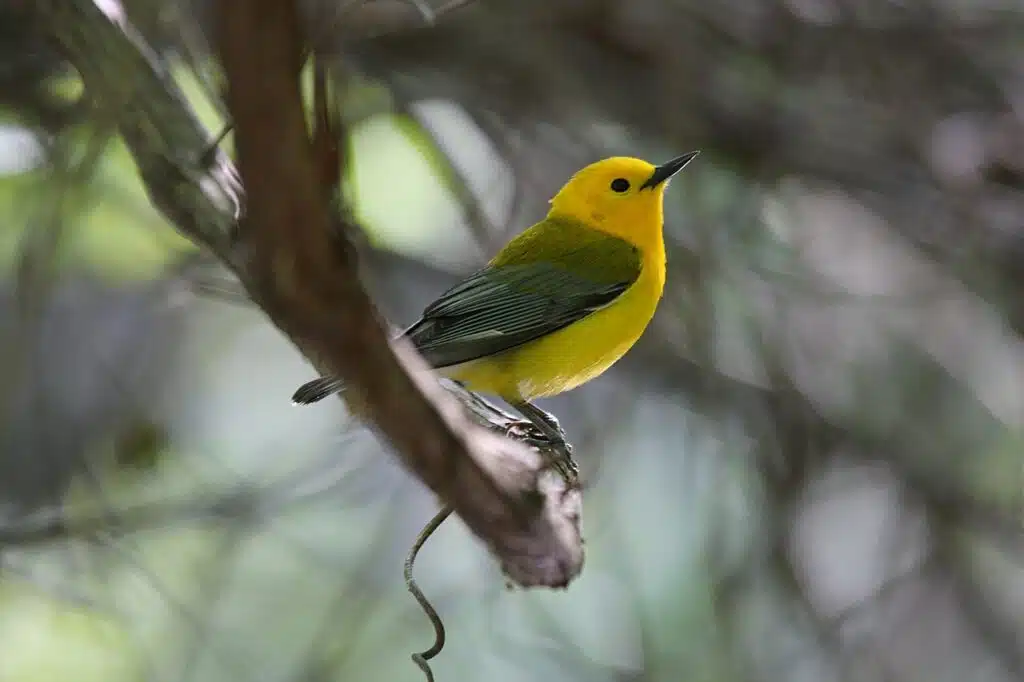
A bright yellow head is seen on male and female Prothonotary Warblers (Protonotaria citrea).
These are small birds native to The United States with bright yellow plumage. Males and females are highly similar but females appear duller.
Male and female Prothonotary Warblers have bright yellow heads of a slightly golden nuance.
This color is also seen in the underbelly of the birds while their wings are dark and slightly yellow at the base.
Gray, black, and white features are specific to the wings of this species.
Prothonotary Warblers inhabit vast territories in North America, from Maine to California.
Most populations are seen in the Southeast, however. These birds also move South to overwinter.
Some Prothonotary Warblers may even reach the woodlands of Northern South America before moving back to North America in the spring.
Distribution – United States, Central America, Northern South America
12. Wilson’s Warbler
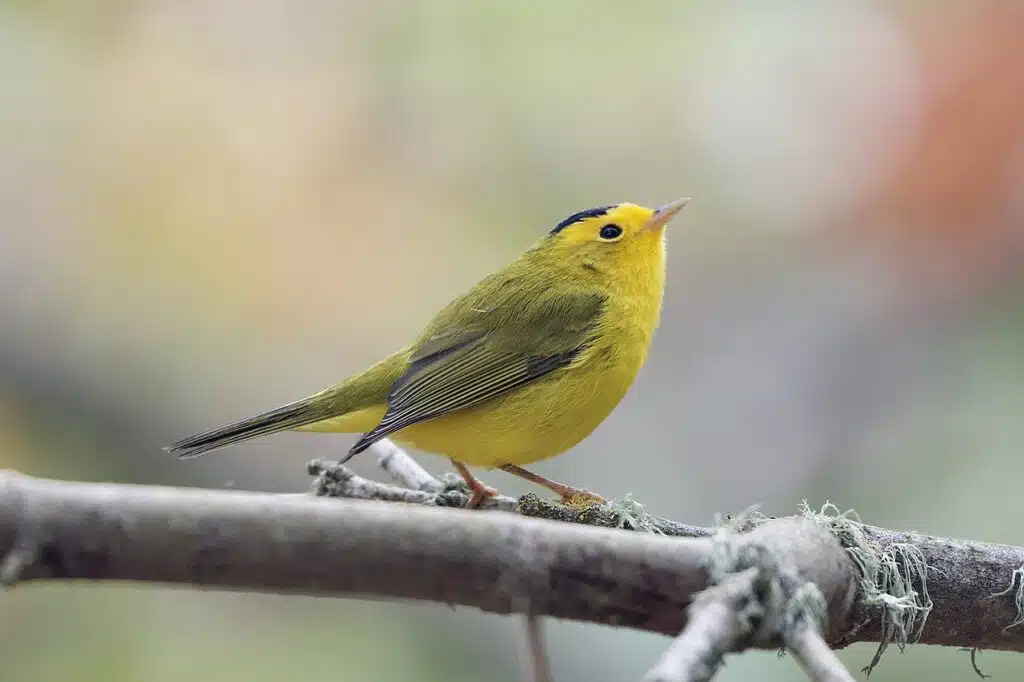
Wilson’s Warblers (Cardellina pusilla) are also found in North America but they breed further North compared to Prothonotary Warblers.
These birds with yellow heads inhabit vast territories of Canada and Alaska where they breed in woodlands.
A long migration process is also specific to Wilson’s Warblers as these birds reach the outskirts of South America to overwinter.
With 3 total subspecies, male Wilson’s Warblers are known for their yellow heads with or without a black crown.
Females may also have a yellow face as this depends on the subspecies and the region.
Found in high numbers in North America, Wilson’s Warbler in its different subspecies grows to a size between 3.9 and 4.7 inches.
It lives and breeds in open areas of hardwood or pine woodlands.
Distribution – Alaska, Canada, Central America, Western Europe
13. Olive Warbler
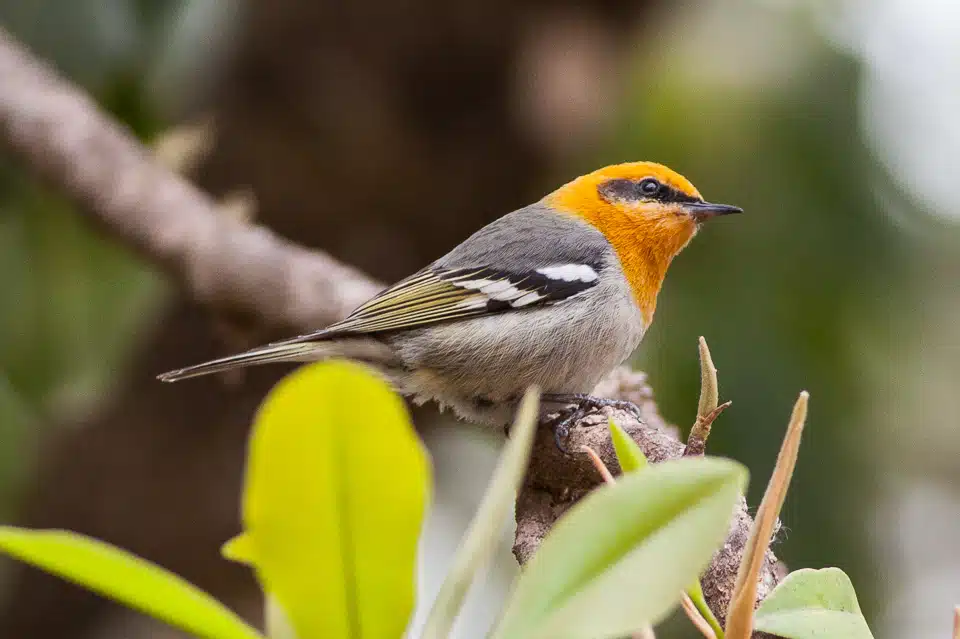
This distinct species of warblers (Peucedramus taeniatus) is one of the few where the female shows a yellow head color.
Male Olive Warblers have an orange head color and are generally seen as more colorful.
Shades of gray dominate the back and the ventral side of the male. Females are dominated by olive nuances with gray, black, and olive wings.
While it has a brighter head nuance, the female bird has a pale yellow nuance and a gray crown. Males have mostly orange heads without gray crowns.
Pine and mixed woodlands are among the breeding territories of Olive Warblers.
US populations show a migratory status.
Olive Warblers are only found in the Southernmost limits of The United States and higher numbers across Mexico and Central America.
Distribution – New Mexico, Arizona, Texas, Mexico
14. Black-throated Green Warbler
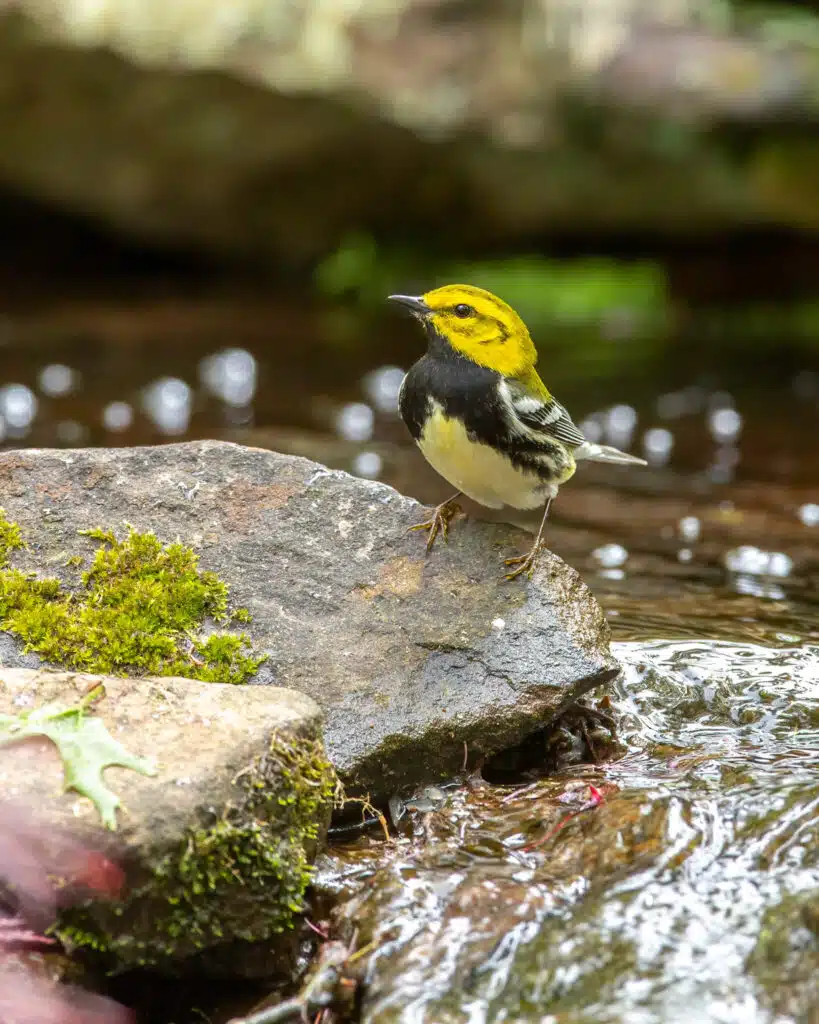
Bright yellow heads are characteristic of The American Black-throated Green Warbler (Setophaga virens).
This is a species named after the black patch or throat of the male bird. Females have a brown throat but both sexes show a yellow head color.
Green or olive-green nuances are also highly characteristic of the sexes. Both males and females have a green upper back and underbelly.
Their wings are black with some white patterns.
Mixed woodlands are among the favorite North American habitats but these warblers have also adapted to swamps in Florida and elsewhere.
These birds can be seen feeding on insects in woodlands across North America and on small fruit in their overwintering range.
Distribution – Eastern Canada, Eastern United States, Central America
15. Blue-winged Warbler
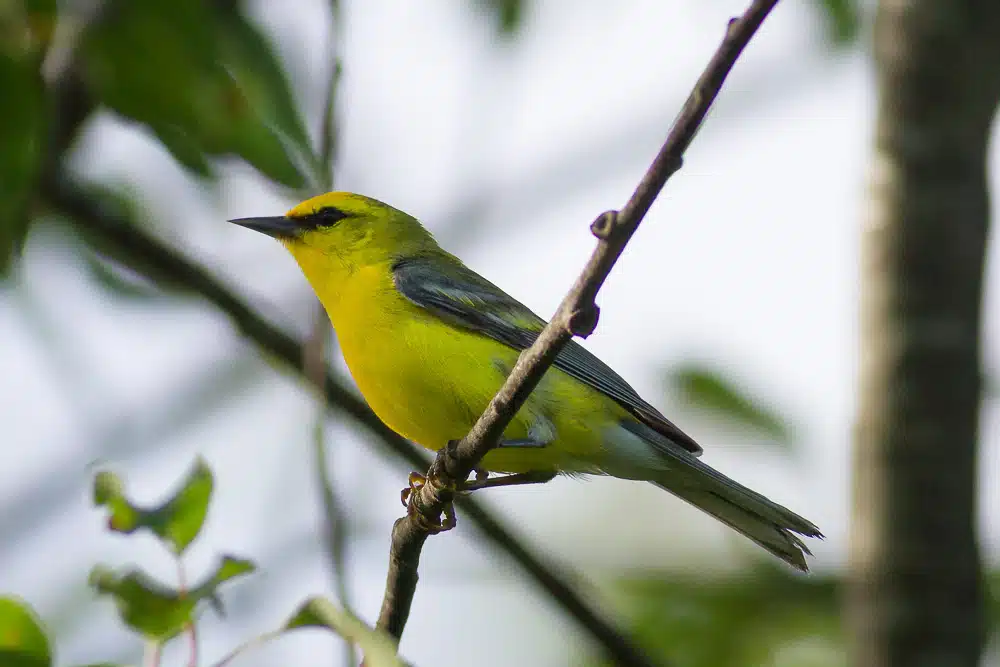
A mostly yellow appearance is specific to The Blue-winged Warbler (Vermivora cyanoptera). This species is named after its atypical blue wings, which also show gray, black, and white sections.
Males and females are both yellow but females have slightly darker plumage.
Yellow nuances also differ on young birds which are also slightly darker compared to males.
Blue-winged Warblers are further known for their dual-colored gray and white beaks.
This is a species with a completely yellow head and a thin black stripe that runs from the dual-colored beak to the eyes.
An arboreal species, Blue-winged Warblers are known for being able to feed while hanging upside down.
Found in woodlands of North America, Blue-winged Warblers have a highly-pitched vocalization.
Distribution – Eastern North America, Central America
16. Hawaiʻi ʻAmakihi
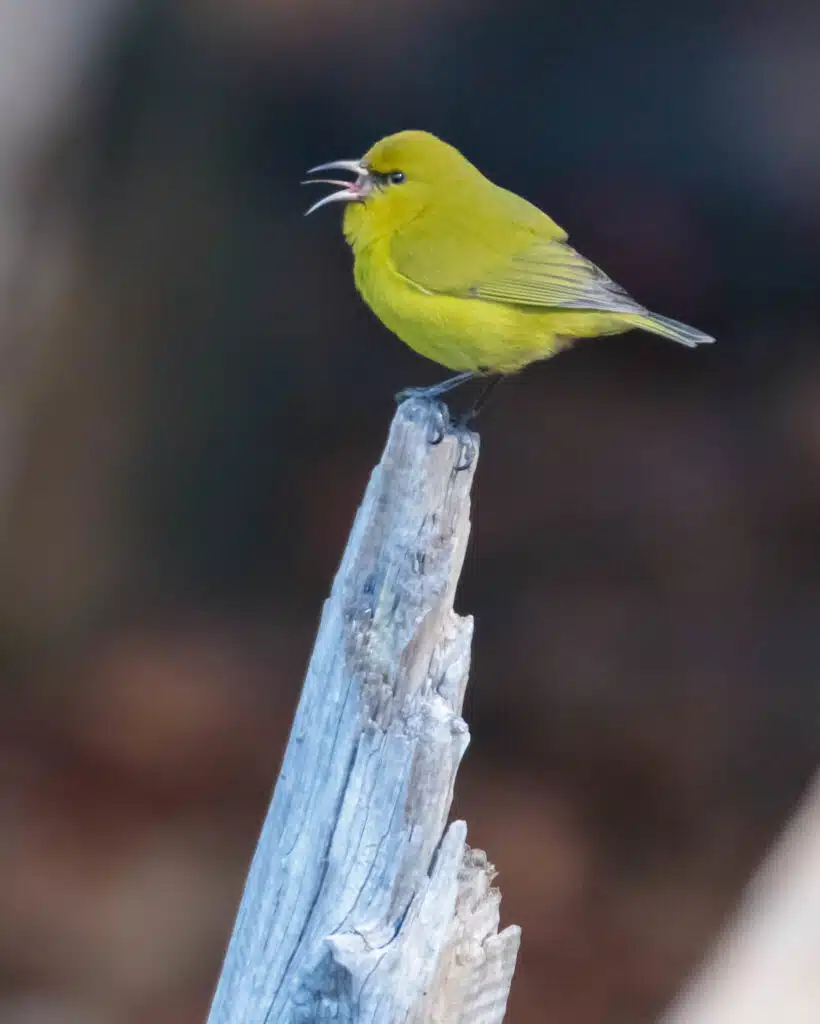
A species endemic to Hawaii, The Hawai’i ‘Amakihi (Chlorodrepanis virens) is a species dominated by a yellow or green appearance.
Its head is almost purely yellow across males and females. Green nuances are further seen along the body and the head of the species, particularly in males.
This species shows feeding adaptations that allow it to consume plant nectar. Having a long tongue is the main adaptation for plant nectar.
A slightly curved beak is another feeding adaptation that allows it to easily pierce plants for nectar.
Only growing to a maximum size of 3.9 inches, these birds show an arboreal nature.
Distribution – Hawaii
17. Palila
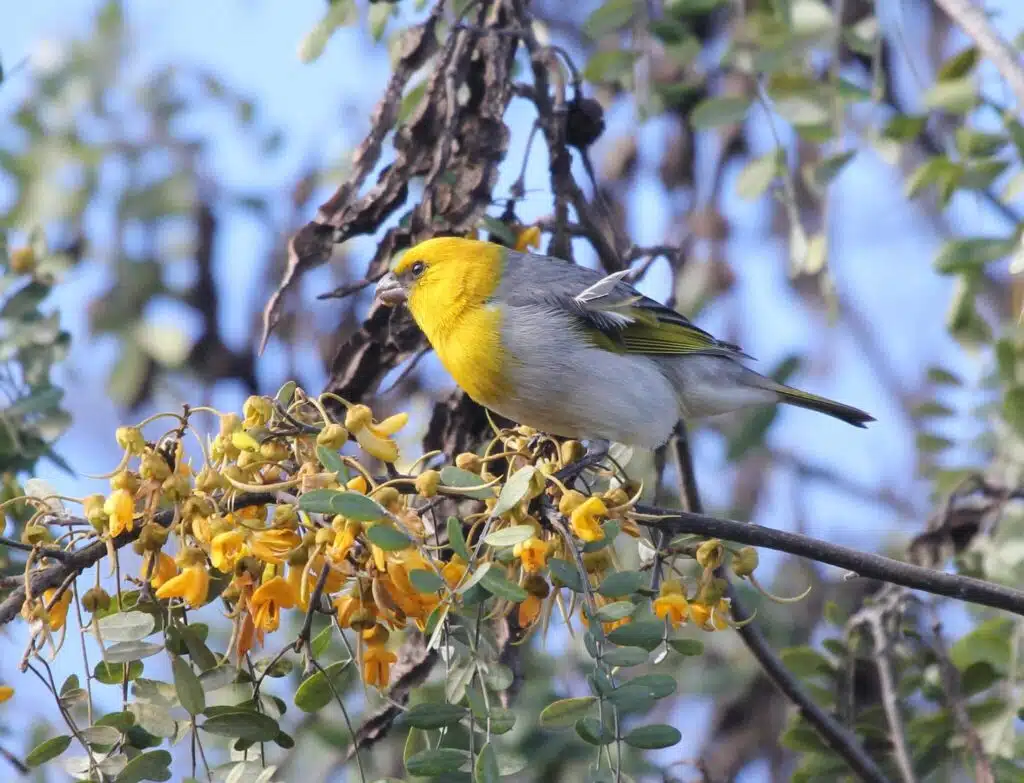
Palilas (Loxioides bailleui) are some of the largest honeycreepers in Central and South America.
Found in Hawaii, these birds grow to a size of over 7 inches and are known for having a yellow head.
Males have bright yellow heads while females show narrow red-brown patterns along their yellow heads.
Females of the species also show a darker yellowhead nuance.
Their wings are dark gray while bright gray nuances are specific to their underbellies.
Highly visible from February to September, this period marks the breeding time of Palila birds.
These arboreal species spend their time among tree canopies and move to flowers and shrubs to feed on nectar.
Distribution – Hawaii Big Island
18. Yellowhammer
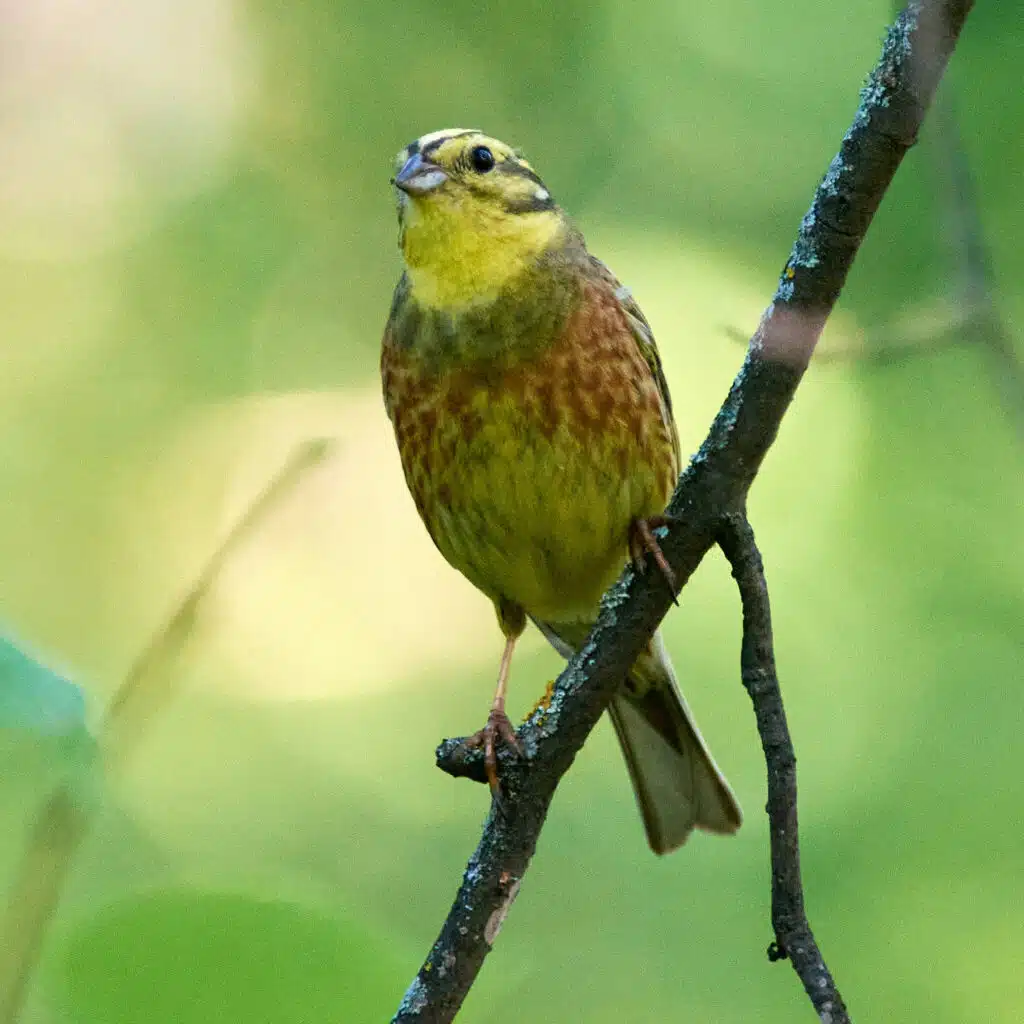
Yellowhammer birds (Emberiza citrinella) are most common in regions of Europe and Asia.
This is a species with a yellow head both in the case of males and females while their underbellies can be yellow or bright brown.
Yellowhammers are known migrators but not all of their populations move to overwinter.
Some of the European and Asian populations move towards The Caspian Sea range to overwinter while others are sedentary.
However, most Yellowhammer populations can survive winters in Europe as they have a varied diet and because they show high adaptability to their environment.
Farms, woodlands, and gardens are among the places these birds can settle in.
In the winter, European Yellowhammers can survive on seeds.
Distribution – Europe, East Asia, Middle East
19. Eurasian Golden Oriole
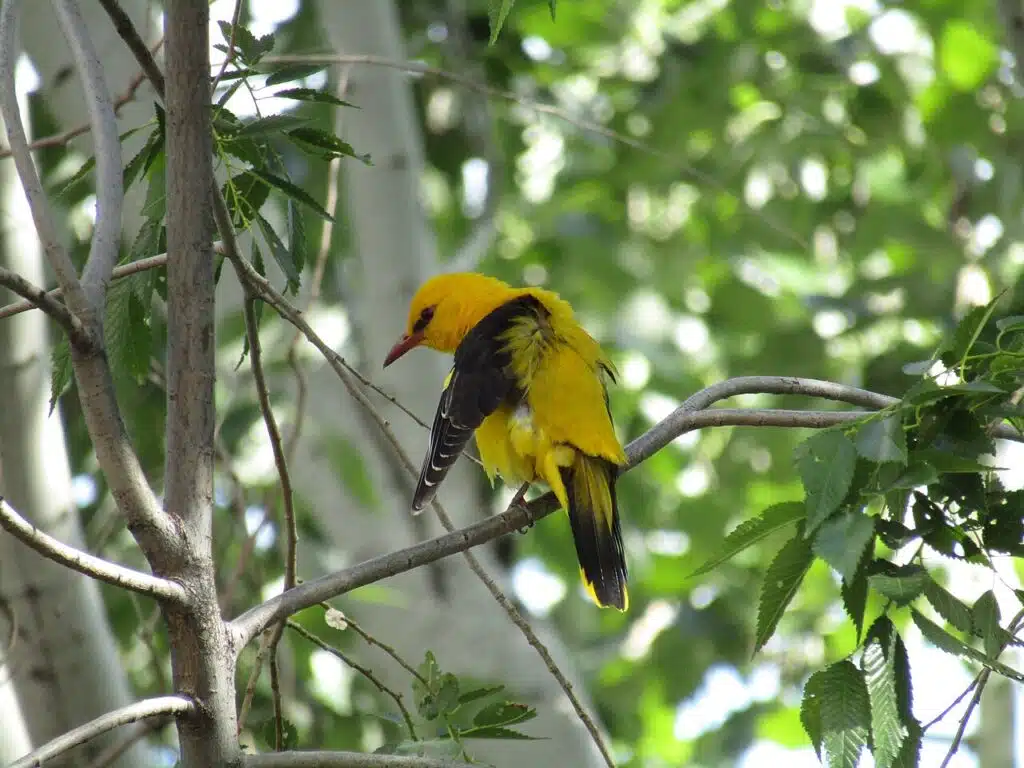
Male and female Eurasian Golden Orioles (Oriolus oriolus) have a golden yellow head. These birds show a bright yellow color in the case of females and a golden nuance in the case of females.
The male has a yellow head, upper back, and underbelly. Its wings are almost completely black.
Females show a pale yellow head and upper back with gray-white underbellies and brown wings with some yellow sections at the base.
A European and Asian native, this specie is a known long-distance migrator.
Not only does it move South to overwinter, but the European populations of The Eurasian Golden Orioles can even reach South Africa.
Its overwintering range includes vast areas of sub-Saharan Africa while its breeding range is spread throughout Europe.
Distribution – Europe, East Asia, Africa
20. Yellow-headed Warbler
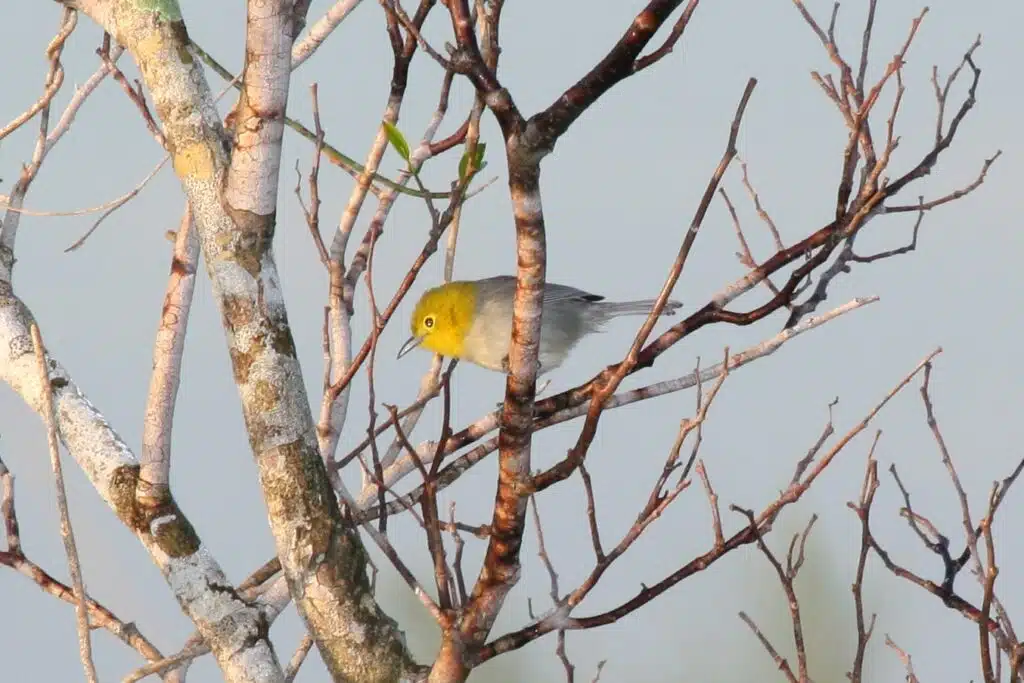
This species of singing bird (Teretistris fernandinae) is native to Cuba. It can be found in all types of habitats on the island.
From open fields to forests, Yellow-headed Warblers are among the contrasting head species of the country.
This is a bird with a gray appearance while its yellow head is the only colorful section.
Brighter yellow nuances are specific to the exposed skin areas around its black eyes.
A bright yellow face and a yellow-green cap are specific to these birds.
The underbelly is bright gray while darker gray nuances or mid-gray nuances are specific to its wings.
Both males and females share these color patterns, with some exceptions.
One of the exceptions includes a Yellow-headed Warbler morph with a yellow chest as well.
An arboreal species, this bird has high-pitched vocalizations and a diverse diet based on seeds and insects.
Distribution – Western Cuba
21. Yellow-headed Brushfinch
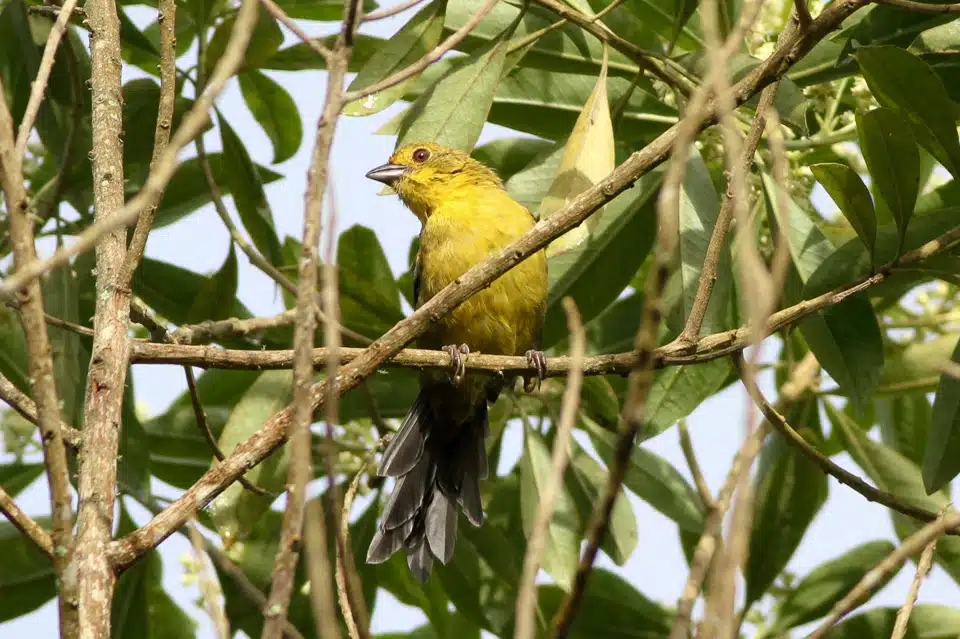
A species dominated by a contrasting appearance, this brushfinch (Atlapetes flaviceps) is native to Colombia.
It lives in old woodlands and different types of fields and crops in the Western parts of the country.
Also known as The Olive-headed Brushfinch, this is a species with a bright yellow head with some black marks.
Birds of the genus have olive to black wings and upper back coloring and are only partly olive on the head.
Females are more likely to show olive spots on the face as opposed to males.
Both males and females further show a yellow chest and belly contrasted by dark wings, black eyes, black bill, and black legs.
The singing nature of the bird offers both high-pitched and low-pitched vocalizations.
Distribution – Colombia
22. Yellow-headed Manakin
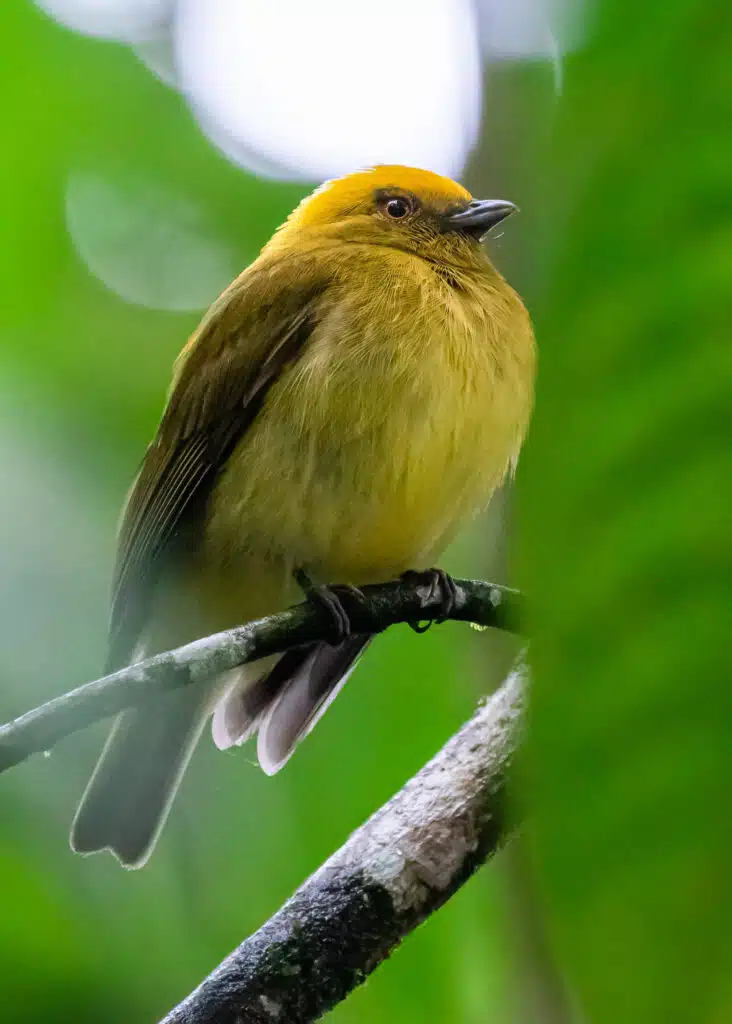
Western Colombian forests are the home to The Yellow-headed Manakin (Chloropipo flavicapilla).
This is a species with a bright multicolored appearance and a bright yellow head. The cap is the brightest yellow part of the head.
Its base wings are also yellow while the rest of the wings are olive and gray. In some cases, purple feathers further contrast the species on the wings.
Bright yellow underbellies are also characteristic of The Yellow-headed Manakin. This is a species that also comes in an orange head cap in the case of females.
A short black beak is further seen on both male and female birds.
Only found in higher elevation forests, these birds are arboreal and change their eye color from brown to red going into the breeding season in the case of the males.
Distribution – Colombia, Ecuador
23. Greater Yellow-headed Vulture
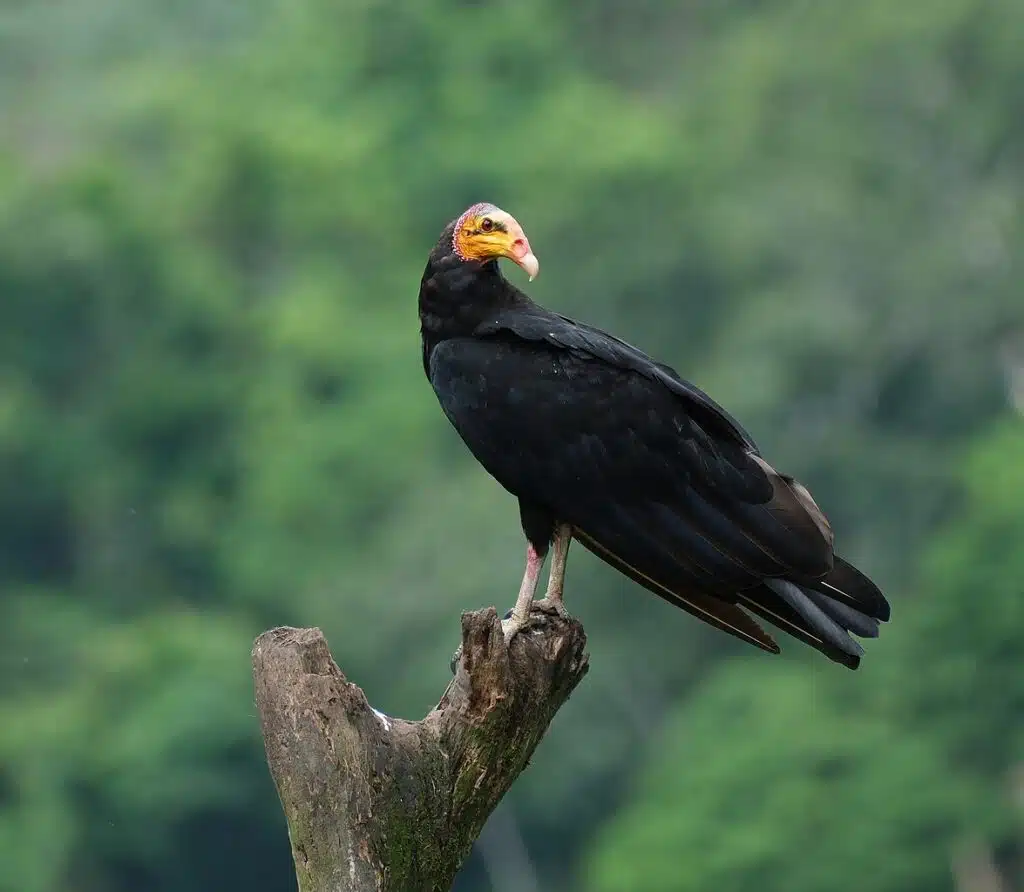
A South American vulture, the bald species (Cathartes melambrotus) is known for its yellow and pink head.
With a wingspan of up to 30 inches, Greater Yellow-headed Vultures are mostly black and contrasted by their very bright heads.
These birds also live around tropical forests where they find the right temperature and food to live on.
Greater Yellow-headed Vultures feed on carrion and are among the few vultures and birds which detect their prey based on smell.
Of course, these vultures also locate rainforest carrion by vision.
The vulture chooses a high vantage point such as a tree to check out its area for food.
Distribution – Northern South America
24. Blackburnian Warbler
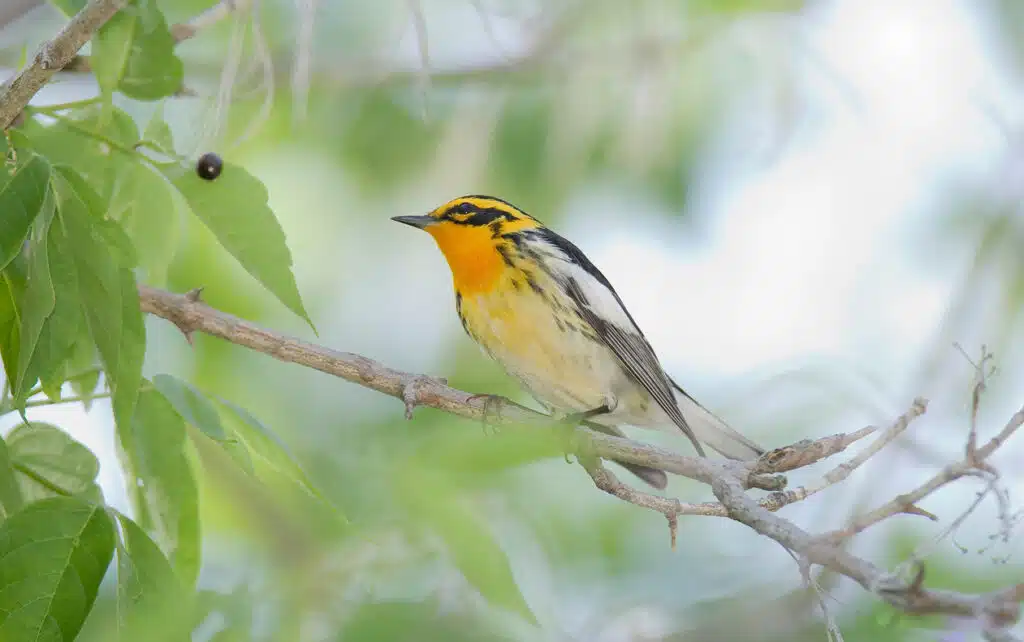
A North American species, The Blackburnian Warbler (Setophaga fusca) is seen in The United States and Canada when it breeds.
Laying eggs in a self-made nest, these birds stand out with their yellow heads and generally contrasting appearance.
The yellow head is contrasted by a black cap. Black sections cover its back and wings. Black streaks can even be spotted on the white underbelly.
Yellow sections are mostly seen on the face and chest of the bird.
This species also changes nuances from yellow to orange, depending on its breeding season.
A long-distance migrator, Blackburnian Warblers leave their breeding sights heading towards Ecuador and Colombia to overwinter.
Distribution – Eastern Canada, Northeastern United States, Northern South America
25. Cape May Warbler
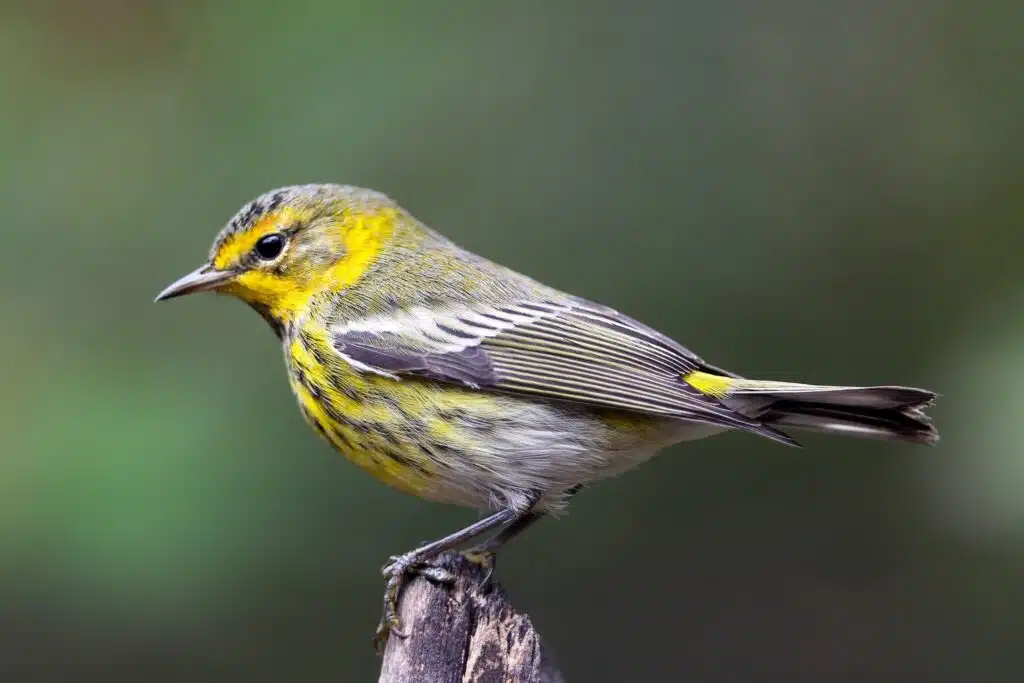
Male and female Cape May Warblers (Setophaga tigrina) are birds with yellow heads. Additional yellow sections are specific to the chest.
Males are multicolored while females are mostly yellow, green, and black.
A purple nuance is further specific to the breeding period male Cape May Warbler.
Bright purple nuances across its underbelly and tail as well as brown-red sections around its eyes mark the plumage changes of the male heading into the breeding season.
Reaching a size of up to 8.7 inches, Cape May Warblers are also some of the largest warblers with yellow heads in North America.
Most of its populations are found along Canadian coniferous woodlands.
Distribution – North America, Europe
26. Saffron Finch
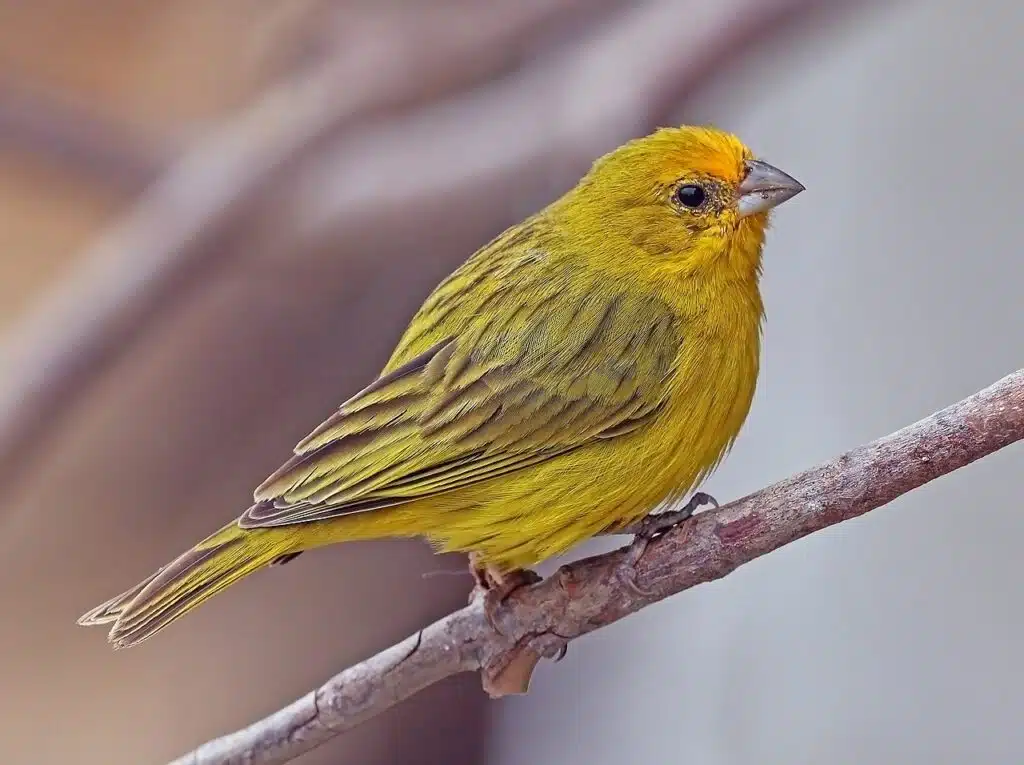
A species of South America, Saffron Finch birds (Sicalis flaveola) have a yellow head across its 5 subspecies.
While similar, male and female Saffron Finches show slight nuance differences. Males have a bright yellow head with yellow plumage.
Females have a yellow-green head with a similar nuance plumage across the underbelly and the wings.
Male Saffron Finches may also exhibit red overlays on the face into the breeding period.
Like other finches, Saffron Finches can live in open habitats but also in urban areas.
The yellow nuances of these birds often confused them with other highly similar species such as The Atlantic Canary.
Distribution – Colombia, Ecuador, Puerto Rico
27. Streak-backed Oriole
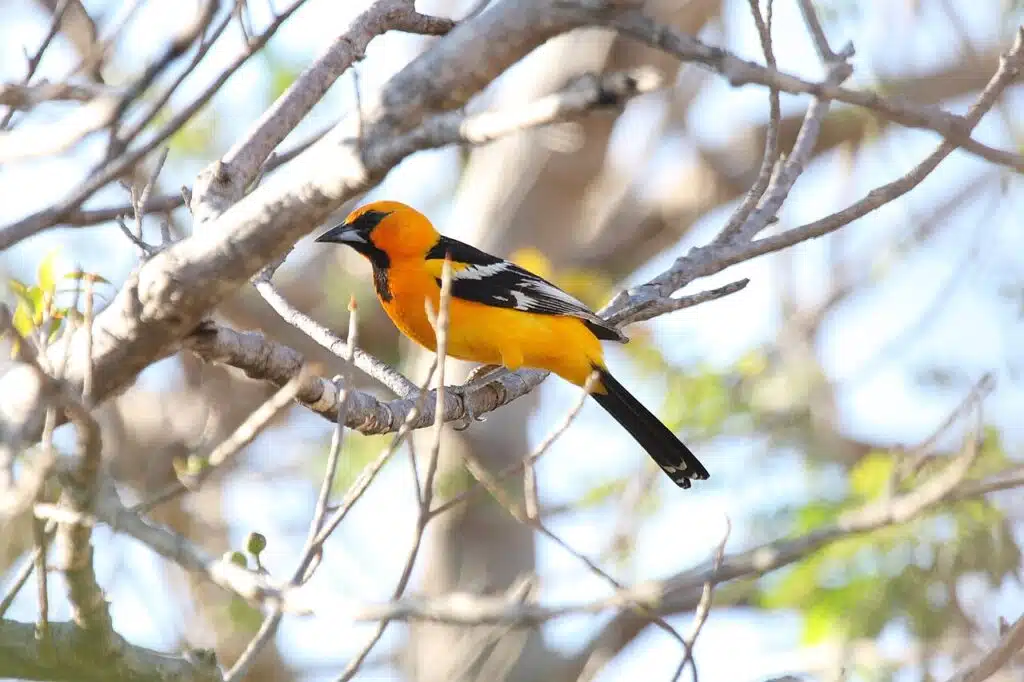
A species often spotted around mimosas, Streaked-backed Orioles (Icterus pustulatus) have yellow or yellow-orange heads.
Male Streaked-backed Orioles have a yellow head and matching nuance necks, upper backs, and underbellies.
Its wings are mostly black, with additional yellow and white streaks, similar to the tail.
The yellow sections of its wings show multiple streaks of black dots.
A Central American species, Streak-backed Orioles are often present in the Southernmost regions of The United States.
Distribution – Mexico, El Salvador, Nicaragua, Guatemala, Honduras, Texas
28. Yellow Grosbeak
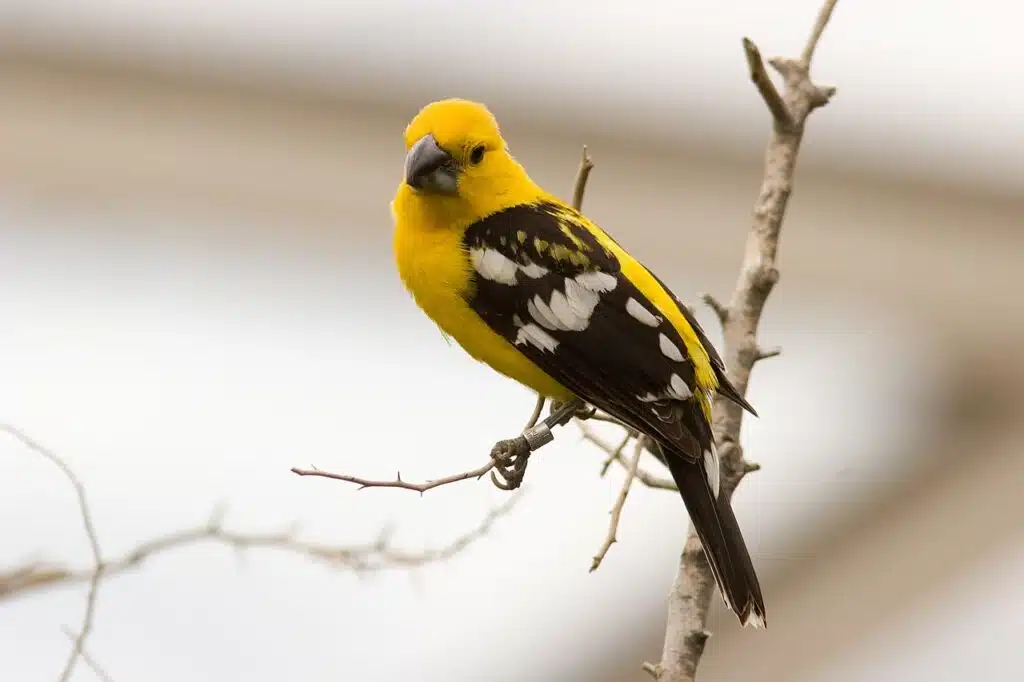
A bright yellow color marks the plumage of The Yellow Grosbeak (Pheucticus chrysopeplus). Its head can be yellow, yellow-red, or yellow-green.
Males are most likely to show yellow and yellow-red oranges while females are more likely to show yellow-green heads.
The head of the male can also be orange-red in the breeding season.
Yellow Grosbeaks also have a dual-colored beak. Black wings with white spots are specific to males while females show dark gray and white wings.
A reduced but constant presence is noted for Yellow Grosbeaks in The United States.
Distribution – Mexico, New Mexico, Arizona, Texas
29. Atlantic Canary
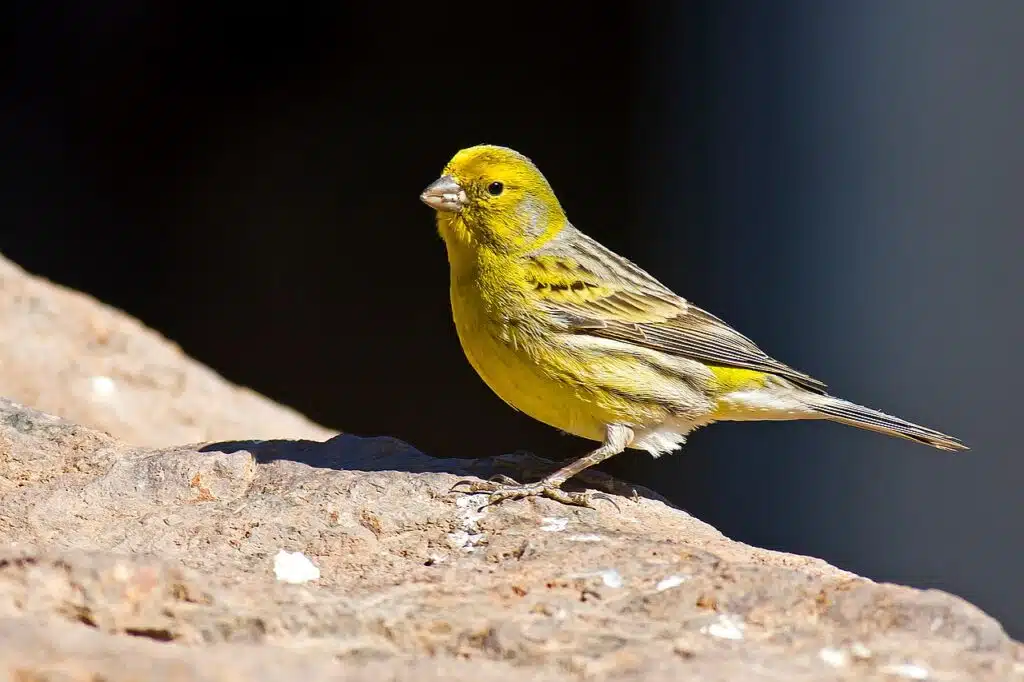
A species of Atlantic Ocean islands such as Madeira, Atlantic Canaries (Serinus canaria) have a bright yellow head.
Females and juveniles have a duller appearance with gray heads and yellow underbellies.
Atlantic Canaries spend their lives looking for food, on the ground. These birds eat seeds and other foods.
Atlantic Canaries live in small flocks. Growing to a size between 3.9 and 4.7 inches, Atlantic Canaries are a status symbol in most of their native habitats.
Distribution – Canary Islands, Madeira, Azores
30. European Serin
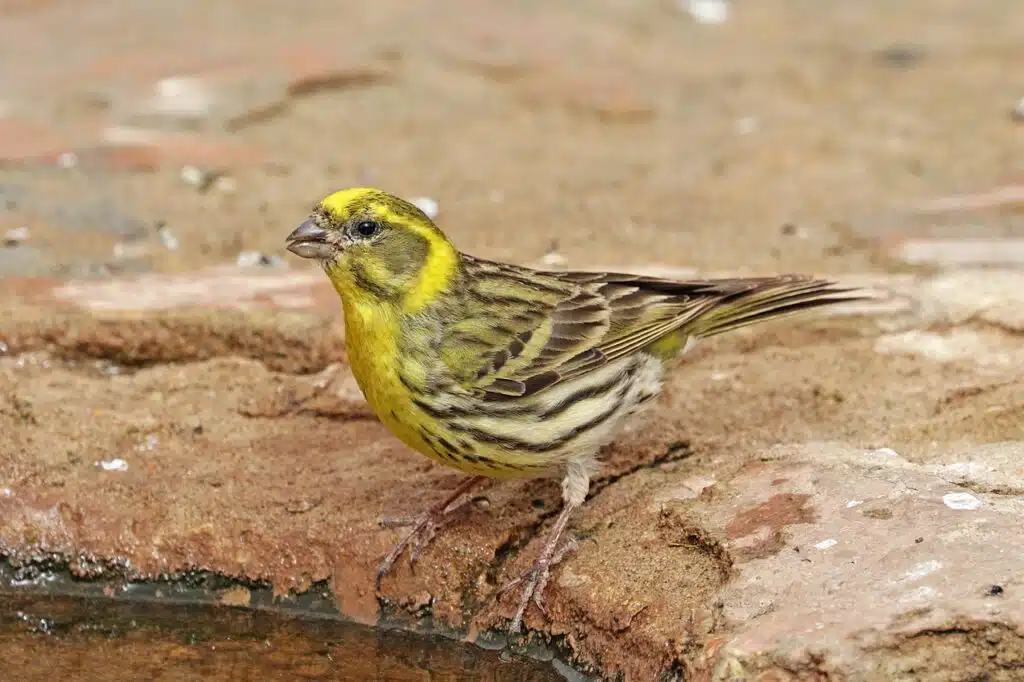
Male European Serins (Serinus serinus) have a yellow head with dark face marks. Females are duller, with gray, black, and brown-streaked plumage.
Yellow nuances on the heads of males are matched by the yellow nuances on their underbelly.
A European sedentary and migratory species, the bird may move toward Africa to overwinter in its Northernmost regions.
European Serins in the Southern parts of the continent don’t migrate to overwinter.
Distribution – Europe